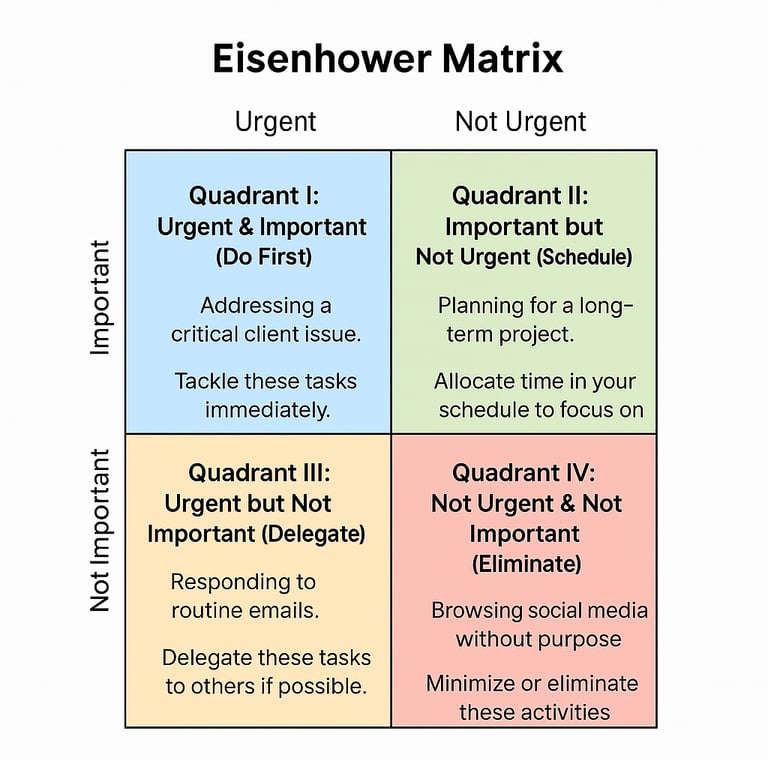Eisenhower Matrix
Overview
The Eisenhower Matrix, also known as the Urgent-Important Matrix, is a time-management tool that assists individuals in prioritising tasks based on their urgency and importance. By categorizing tasks into four distinct quadrants, it aids in decision-making, ensuring that attention is directed toward activities that align with one's goals and values.
This matrix helps users distinguish between tasks that require immediate attention and those that contribute to long-term objectives, promoting effective time allocation and productivity.
Origin
The concept is attributed to Dwight D. Eisenhower, the 34th President of the United States and a five-star general during World War II. In a 1954 speech, Eisenhower quoted an unnamed university president:
“I have two kinds of problems, the urgent and the important. The urgent are not important, and the important are never urgent.”
This philosophy laid the foundation for the matrix, emphasizing the need to prioritize tasks that are truly important over those that merely appear urgent.
Evolution
The matrix gained widespread popularity through Stephen Covey's book The 7 Habits of Highly Effective People, where it was presented as a tool for effective personal management. Over time, it has been adapted for various applications, including project management, strategic planning, and personal productivity.
Modern adaptations have integrated the matrix into digital tools and apps, allowing for dynamic task management and prioritization in today's fast-paced environments.
Significant Use Cases
Personal Productivity: Managing daily tasks and avoiding procrastination.
Project Management: Prioritizing project activities based on deadlines and impact.
Strategic Planning: Focusing on long-term goals over immediate but less important tasks.
Leadership: Delegating tasks effectively and concentrating on high-impact decisions.
Use Case Categories
Leadership & Management
Personal Development
Project & Operations Management
Strategic Planning
Time Management
Sample Use Case and Step-by-Step Guide
Quadrant I: Urgent & Important (Do First)
Example: Addressing a critical client issue.
Action: Tackle these tasks immediately.
Quadrant II: Important but Not Urgent (Schedule)
Example: Planning for a long-term project.
Action: Allocate time in your schedule to focus on these tasks.
Quadrant III: Urgent but Not Important (Delegate)
Example: Responding to routine emails.
Action: Delegate these tasks to others if possible.
Quadrant IV: Not Urgent & Not Important (Eliminate)
Example: Browsing social media without purpose.
Action: Minimize or eliminate these activities.


Visual Representation
Decision Design Lab Interpretation
At Decision Design Lab, we view the Eisenhower Matrix as more than a time-management tool; it's a framework for intentional living.
By continuously evaluating tasks through the lenses of urgency and importance, individuals can align their daily actions with their core values and long-term objectives, fostering a reflective and purpose-driven approach to decision-making.
Scholarly Work Links
Essential Reads & Interpretations
The 7 Habits of Highly Effective People by Stephen R. Covey
First Things First by Stephen R. Covey, A. Roger Merrill, and Rebecca R. Merrill
The Eisenhower Matrix: How To Be More Productive by Mark Selo
Authors
Stephen R. Covey: Popularized the matrix in his book The 7 Habits of Highly Effective People.
Mark Selo: Authored a practical guide on implementing the Eisenhower Matrix for productivity.
Author-Framework Websites
Eisenhower.me: Offers tools and resources related to the Eisenhower Matrix.
We recommend EisenhowerMatrix.net for browser-based practice: https://eisenhowermatrix.net
Video Link
Eisenhower Matrix Explained - YouTube
Rich Visuals
Eisenhower Matrix Diagram - Dreamstime
Eisenhower Matrix Template - Lucidchart


